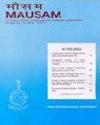印度喜马拉雅山脉西部查谟和克什米尔以及拉达克地区降水和温度的极值分析
IF 0.7
4区 地球科学
Q4 METEOROLOGY & ATMOSPHERIC SCIENCES
引用次数: 0
摘要
气候变化已成为当今世界的一个重大问题。喜马拉雅地区气候的微小变化都会对脆弱的生态系统产生重大影响,而生态系统对这种变化非常敏感。 最近对西喜马拉雅山脉气候变化的调查提供了令人信服的证据,表明这些地区特别容易发生各种灾难性事件。在当前情况下,气候变化对查谟和克什米尔(J&K)以及拉达克地区人类生存的威胁变得更加具体和明显。温度和降水量统计数据可用来观察这种区域气候变化。本研究利用查谟和克什米尔以及拉达克 14 个地区从 1901 年到 2002 年长达一个世纪的数据集,对降水和温度的长期时空变化进行了分析和预测。对数据进行的增量迪基-富勒(ADF)检验和夸特科夫斯基-菲利普斯-施密特-辛(KPSS)静态检验表明,时间序列是静态的。极值理论(EVT)是一种出色的统计方法,可用于解释记录以估计未来极端事件发生的概率。此外,还分别预测了 50、80、100、120、200、250、300 和 500 年回归期的极端降水和温度,结果显示,查谟、拉朱里、列、斯利那加、巴拉穆拉和蓬奇等地区将更容易出现极端天气事件现象。本文章由计算机程序翻译,如有差异,请以英文原文为准。
Extreme value analysis of precipitation and temperature over Jammu & Kashmir and Ladakh in western Himalaya, India
Climate change has become a major issue for the world today. Small changes in the climate in the Himalayan region can have a significant impact on the delicate ecosystem, which is very sensitive to such changes. Recent investigations into climate change in the Western Himalayas have provided compelling evidence that these regions are especially susceptible to a wide variety of catastrophic occurrences. In the current scenario, the threat posed by climate change to human existence in Jammu and Kashmir (J&K), as well as the region of Ladakh, has grown more tangible and evident. Temperature and precipitation statistics could be used to observe this regional climatic shift. This study analyses and forecasts long-term spatio-temporal variations in precipitation and temperature using a century-long dataset from 1901 to 2002 over 14 districts of Jammu and Kashmir and Ladakh. The Augmented Dickey-Fuller (ADF) test and the Kwiatkowski-Phillips-Schmidt-Shin (KPSS) test of stationarity on the data show that the time series is stationary. Extreme Value Theory (EVT), which is an outstanding statistical method to interpret the records for the estimation of the future probability of the occurrence of extremes, is utilised in this study. Further, precipitation and temperature extremes are forecasted for 50, 80, 100, 120, 200, 250, 300, and 500 year return periods respectively and results reveal that the districts- Jammu, Rajouri, Leh, Srinagar, Baramulla and Poonch will be more prone to extreme weather events phenomenon.
求助全文
通过发布文献求助,成功后即可免费获取论文全文。
去求助
来源期刊

MAUSAM
地学-气象与大气科学
CiteScore
1.20
自引率
0.00%
发文量
1298
审稿时长
6-12 weeks
期刊介绍:
MAUSAM (Formerly Indian Journal of Meteorology, Hydrology & Geophysics), established in January 1950, is the quarterly research
journal brought out by the India Meteorological Department (IMD). MAUSAM is a medium for publication of original scientific
research work. MAUSAM is a premier scientific research journal published in this part of the world in the fields of Meteorology,
Hydrology & Geophysics. The four issues appear in January, April, July & October.
 求助内容:
求助内容: 应助结果提醒方式:
应助结果提醒方式:


